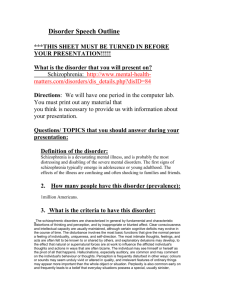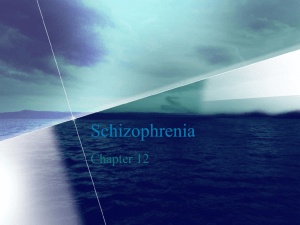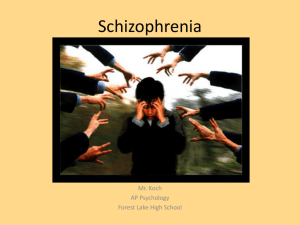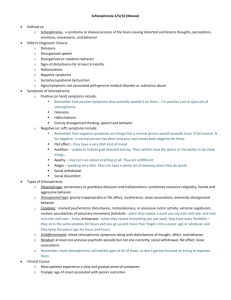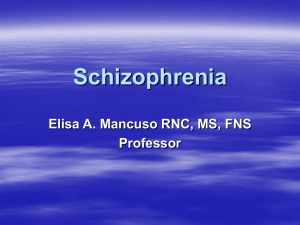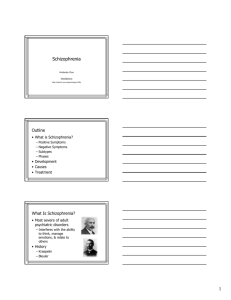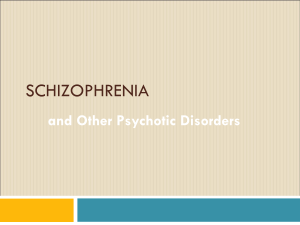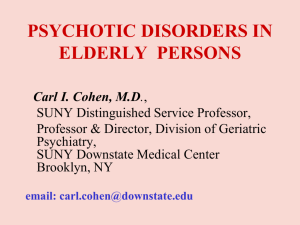Schizophrenia - School of Psychiatry
advertisement
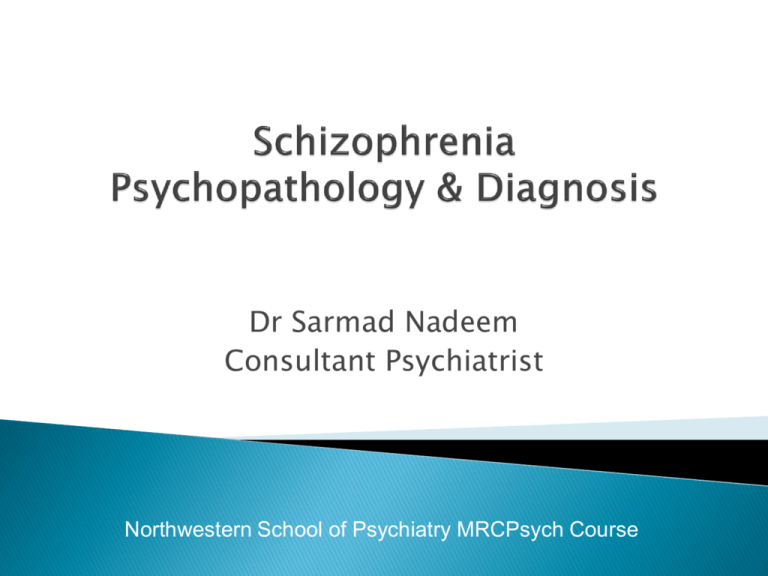
Dr Sarmad Nadeem Consultant Psychiatrist Northwestern School of Psychiatry MRCPsych Course ICD-10 diagnosis Course Subtypes Clinical features Differential diagnosis The Schizophrenic disorders are characterised in general by fundamental & characteristic distortions of thinking, perception& affects that are inappropriate or blunted 1 of the following A) B) C) D) Thought alienation Delusions of control ,influence or passivity ,actions or sensations, delusional perceptions Hallucinatory voices (running commentary Discussing the patients between them) Persistent delusions (culturally inappropriate or completely impossible) 2 of the following A) Persistent hallucinations in any modality B) Neologisms ,breaks in the train of thoughts , resulting in incoherent or irrelevant speech (FTD) C) Catatonic behaviour D) Negative symptoms Pattern of course In view of the considerable variation of the course of schizophrenic disorders it may be desirable (especially for research) to specify the pattern of course by using a fifth character. Course should not usually be coded unless there has been a period of observation of at least 1 year. Continuous No remission of psychotic symptoms throughout the period of observation. Episodic with progressive deficit Progressive development of negative symptoms in the intervals between psychotic episodes. Episodic with stable deficit Persistent but non-progressive symptoms in the intervals between psychotic episodes. Episodic remittent Complete or virtually complete remissions between psychotic episodes. Incomplete remission Complete remission Other Course uncertain, period of observation too short Paranoid ( the commonest subtype) Hebephrenic Catatonic Undifferentiated Post-Schizophrenic depression Residual schizophrenic depression Residual Schizophrenia Simple Schizophrenia Other Schizophrenia Schizophrenia ,unspecified Paranoid schizophrenia The general criteria for schizophrenia must be met. Delusions or hallucinations must be prominent (such as delusions of persecution, reference, exalted birth, special mission, bodily change, or jealousy; threatening or commanding voices, hallucinations of smell or taste, sexual or other bodily sensations). Flattening or incongruity of affect, catatonic symptoms, or incoherent speech must not dominate the clinical picture, although they may be present to a mild degree. The general criteria for schizophrenia must be met. Either of the following must be present: definite and sustained flattening or shallowness of affect; definite and sustained incongruity or inappropriateness of affect. Either of the following must be present: behaviour that is aimless and disjointed rather than goal-directed; definite thought disorder, manifesting as speech that is disjointed, rambling, or incoherent. Hallucinations or delusions must not dominate the clinical picture, although they may be present to a mild degree The general criteria for schizophrenia must eventually be met, although this may not be possible initially if the patient is uncommunicative. For a period of at least 2 weeks one or more of the following catatonic behaviours must be prominent: stupor (marked decrease in reactivity to the environment and reduction of spontaneous movements and activity) or mutism; excitement (apparently purposeless motor activity, not influenced by external stimuli); posturing (voluntary assumption and maintenance of inappropriate or bizarre postures); negativism (an apparently motiveless resistance to all instructions or attempts to be moved, or movement in the opposite direction); rigidity (maintenance of a rigid posture against efforts to be moved); waxy flexibility (maintenance of limbs and body in externally imposed positions); command automatism (automatic compliance with instruction). The general criteria for schizophrenia must be met. Either of the following must apply: insufficient symptoms to meet the criteria for any of the subtypes so many symptoms that the criteria for more than one of the subtypes listed above are met. The general criteria for schizophrenia must have been met within the past 12 months but are not met at the present time. One of the conditions in Criterion G1(2) a, b, c, or d for general schizophrenia must still be present. The depressive symptoms must be sufficiently prolonged, severe, and extensive to meet criteria for at least a mild depressive episode. The general criteria for schizophrenia must have been met at some time in the past but are not met at the present time. At least four of the following negative symptoms have been present throughout the previous 12 months: psychomotor slowing or underactivity; definite blunting of affect; passivity and lack of initiative; poverty of either the quantity or the content of speech; poor nonverbal communication by facial expression, eye contact, voice modulation, or posture; poor social performance or self-care. There is slow but progressive development, over a period of at least 1 year, of all three of the following: a significant and consistent change in the overall quality of some aspects of personal behaviour, manifest as loss of drive and interests, aimlessness, idleness, a selfabsorbed attitude, and social withdrawal; gradual appearance and deepening of negative symptoms such as marked apathy, paucity of speech, underactivity, blunting of affect, passivity and lack of initiative, and poor nonverbal communication (by facial expression, eye contact, voice modulation, and posture); marked decline in social, scholastic, or occupational performance. Other schizophrenia Schizophrenia, unspecified Delusions ◦ Firmly held beliefs ◦ Contrary to reality ◦ Resistant to disconfirming evidence Persecutory delusions common ◦ Sensory experiences in the absence of sensory stimulation Other common forms : ◦ Thought insertion ◦ Thought broadcasting ◦ Grandiose delusions ◦ Ideas of reference Types of hallucinations ◦ Audible thoughts ◦ Voices commenting ◦ Voices arguing “The CIA planted a listening device in my head” Hallucinations Increased levels of activity in Broca’s area during hallucinations Avolition Lack of interest; apathy Alogia Reduction in speech Anhendonia Inability to experience pleasure Consummatory pleasure Anticipatory pleasure Flat affect Exhibits little or no affect in face or voice Asociality Inability to form close personal relationships Negative symptoms predict poor quality of life posthospitalization Disorganized speech (Formal thought disorder) Incoherence Inability to organize ideas Loose associations (derailment) Rambles, difficulty sticking to one topic Disorganized behaviour Odd or peculiar behaviour Silliness, agitation, unusual dress Catatonia Motor abnormalities Repetitive, complex gestures Usually of the fingers or hands Excitable, wild flailing of limbs Catatonic immobility Maintain unusual posture for long periods of time e.g., stand on one leg Waxy flexibility- limbs can be manipulated and posed by another person Inappropriate affect- Emotional responses inconsistent with situation e.g. laugh uncontrollably at a funeral Only Schizotypal PD is aetiologically related to Schizophrenia Eccentricity Affect constriction Excessive social anxiety 10% of patients commit suicide Early in illness Paranoid schizophrenics 3 times more likely than non paranoid schizophrenic to commit suicide ROY IN 1982 found that its more likely in following cases: Being male Being young Being unemployed Having chronic illness ,relapse and remissions Having a high educational attainment level prior to onset Akathesia Abrupt stoppage of drugs Recent discharge from inpatient care Wide Initially a lot of uncertainty In general Broader range of psychotic symptoms Greater functional impairment Substance induced psychotic disorder Psychotic disorder due to general medical condition (Head injury, CNS infection, CNS tumour, TLE, Epilepsy , Metabolic or endocrine disorder) Mood disorder with psychotic features Delusional disorder Kaplan & Sadock’s synopsis of Psychiatry Revision notes in Psychiatry NICE Guidelines Oxford Shorter text book in psychiatry Oxford Handbook of Psychiatry Any questions Thank you


